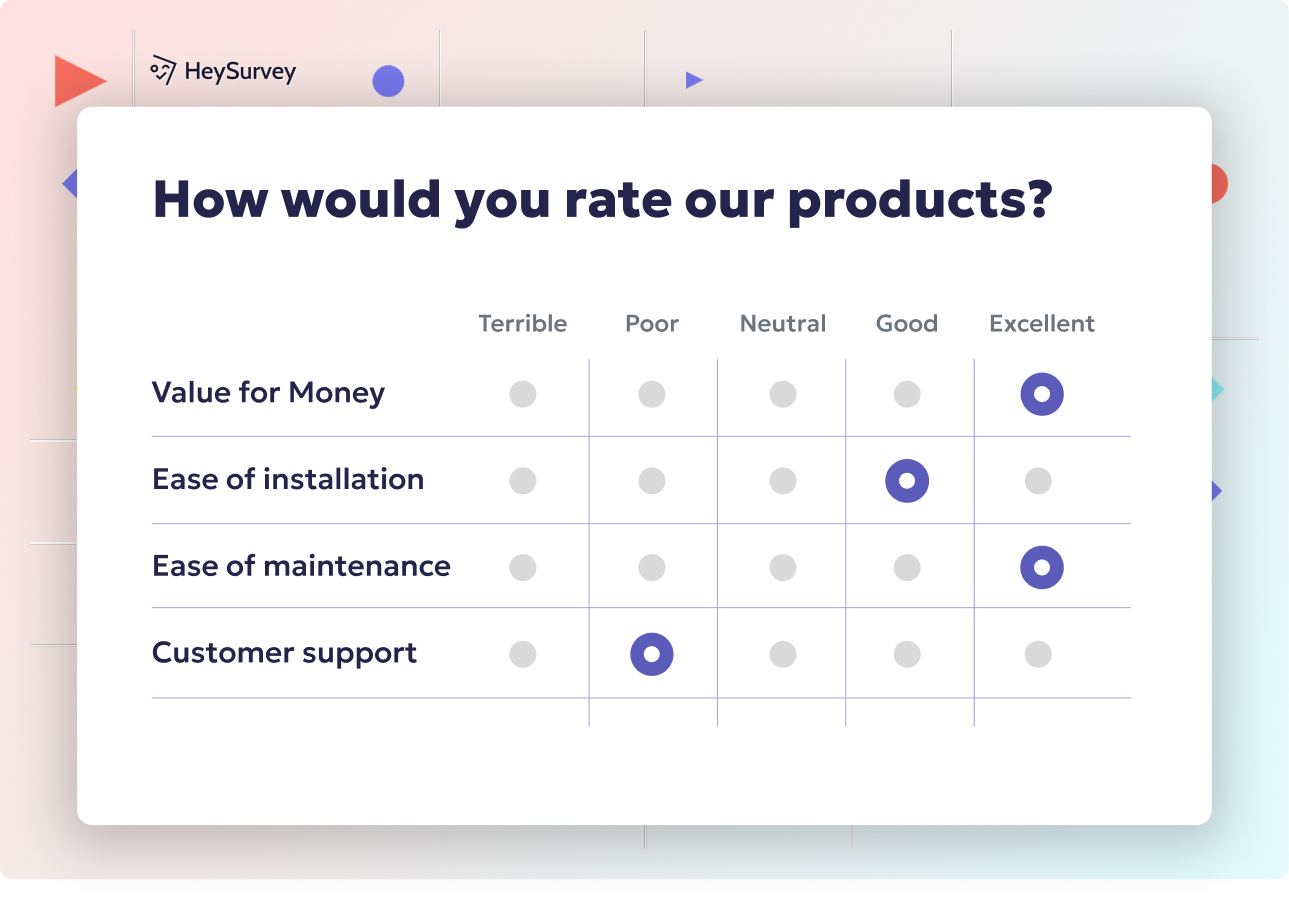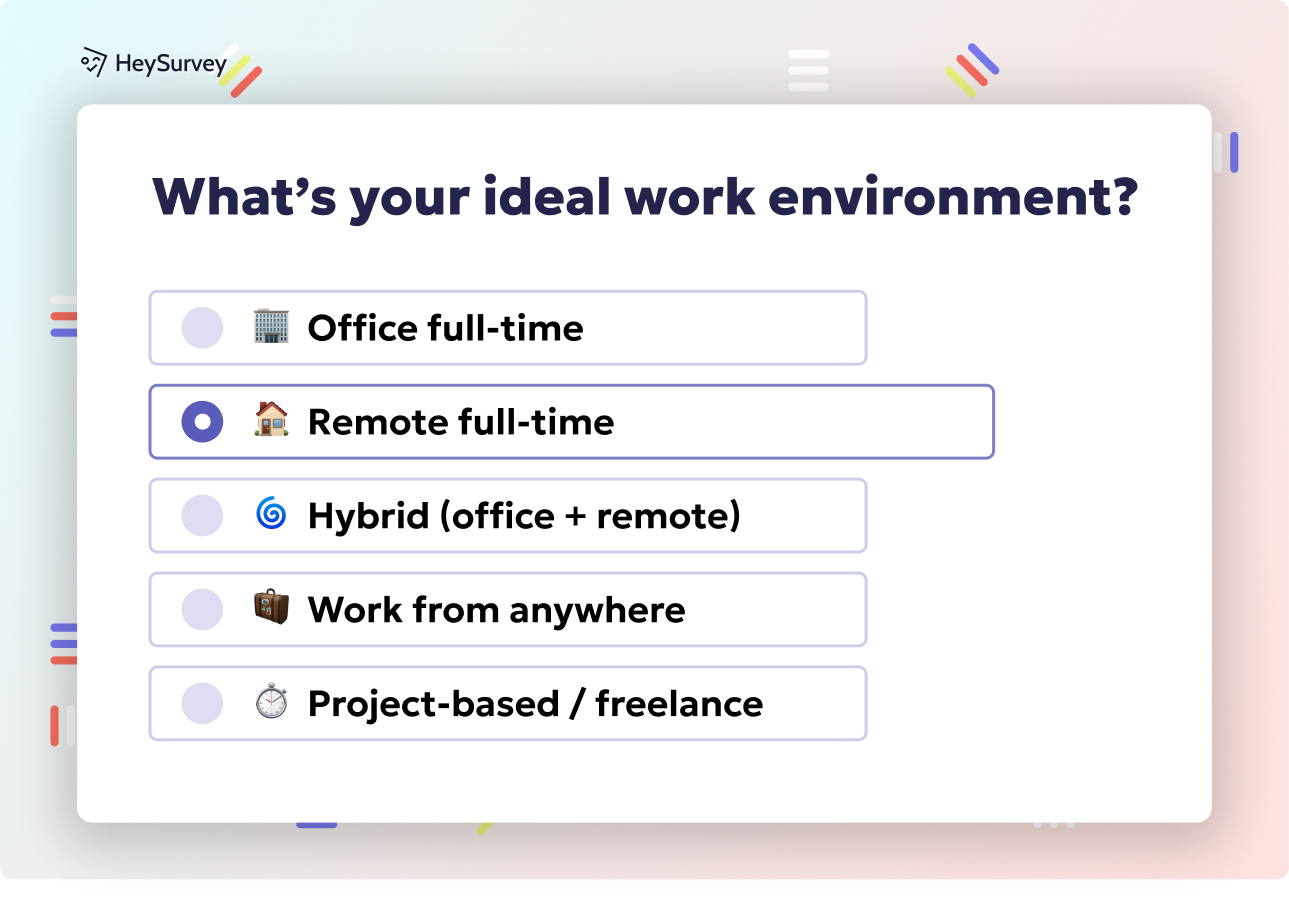31 Diversity Survey Questions to Improve Workplace Inclusion
Explore 30+ diversity survey questions across 6 key types to measure workplace belonging, inclusion, pay equity, hiring, and culture effectively.
Every company says they care about diversity, but how do you actually prove it? This is where diversity survey questions make all the difference. Unlike regular employee surveys, diversity surveys zoom in on inclusion, equity, and how connected people feel at work. The results help organizations stay out of legal hot water, keep talented employees, boost innovation, and polish their reputation. You’ll mostly see these surveys appear during onboarding, annual check-ins, after training sessions, or amid M&A shakeups. From demographic queries to culture check-ins, this article will help you find the DEI metrics you need to genuinely measure and nurture workplace belonging, whatever stage your company is in.
Demographic Diversity Surveys
Why & When to Use This Type
Gathering demographic diversity survey questions isn’t just about ticking boxes—it’s about painting a clear, honest picture of who makes up your workforce. Companies often use these during recruitment cycles, yearly census moments, or before rolling out any shiny new DEI initiatives. This isn’t about prying; it’s about gaining the kind of numbers that help you stay compliant (think EEO rules) and honest about your hiring and pay practices.
Here’s why you might reach for a demographic survey: - To benchmark your organization against industry standards. - To ensure you’re meeting equal employment opportunity regulations. - To get serious about pay equity analyses. - To build a stronger business case when presenting DEI initiatives to leadership. - To spot gaps or trends in your pipeline before launching new hiring campaigns.
You want these results to be as accurate as possible, so timing matters. Many companies do this: - When onboarding new hires to capture the freshest data. - During an annual employee census. - Before introducing new benefits, resource groups, or equitable pay plans.
Used right, demographic surveys can reveal patterns hiding below the surface and help leaders take targeted action—without anyone feeling like just another tick in a spreadsheet. The goal? Make sure the way you see your workplace matches the reality of your employees’ backgrounds.
5 Sample Questions
- Which of the following best describes your gender identity?
- What is your race or ethnicity? (Select all that apply)
- Do you identify as a member of the LGBTQ+ community?
- What is your disability status?
- What is your veteran status?
A well-crafted demographic diversity survey makes it easier to address representation gaps and set the stage for more meaningful, data-driven change. Just remember to always offer a “prefer not to say” option—participation should never feel forced.
Effective demographic diversity surveys should include inclusive questions that allow employees to self-identify across a spectrum of identities, ensuring all individuals feel seen and respected. (thediversitymovement.com)
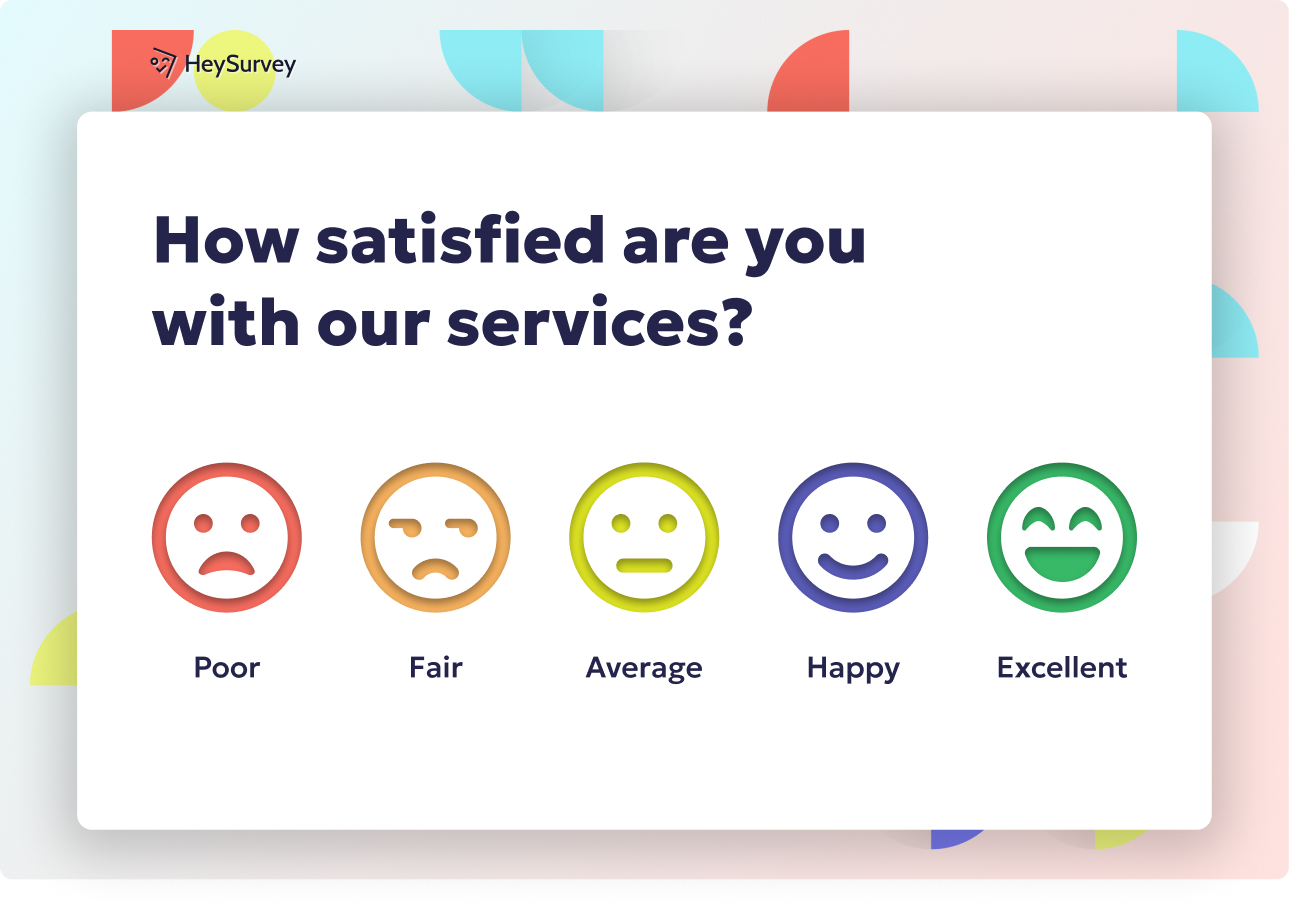
Creating a diversity survey with HeySurvey is simple, even if you’re new to the platform. Follow these three easy steps to launch your survey and start gathering vital insights:
Step 1: Create a New Survey
- Head to HeySurvey and either start with a blank survey or choose a relevant template to save time.
- Give your survey a clear internal name so you can find it easily later.
- If you want, add a short description that lets respondents know what the survey is about and why their participation matters.
Step 2: Add Your Questions
- Click the Add Question button to add the type of question you need—multiple choice, scale, text input, or statement.
- Type in your diversity survey questions, like those asking about gender identity or sense of belonging.
- Use options such as multi-select for race or ethnicity questions and enable the “prefer not to say” choice to keep answers comfortable and inclusive.
- Feel free to insert images or format question text to make the survey more engaging and easy to follow.
Step 3: Publish Your Survey
- Click the Preview button to see exactly how your survey looks on different devices.
- Once you’re happy, hit Publish. You’ll need a HeySurvey account to publish and collect responses.
- Copy the shareable link or embed it on your website or in an email campaign to start gathering feedback.
Bonus Step 1: Apply Your Branding
- Use the Designer Sidebar to add your company’s logo and customize colors, fonts, and backgrounds so the survey feels like an extension of your brand.
- This small touch helps build trust as employees see familiar visuals that reinforce company values.
Bonus Step 2: Define Advanced Settings
- Set start and end dates to control when the survey is available.
- Decide if you want to limit the number of responses or redirect participants to a thank-you page after completion.
- Enable options like allowing respondents to view results if it suits your transparency goals.
Bonus Step 3: Use Branching for a Tailored Experience
- Add branching logic so questions adapt based on prior answers—for example, skip demographic questions irrelevant to certain groups.
- This helps keep surveys shorter and more relevant, improving completion rates and data quality.
Ready to get started? Open a diversity survey template below and watch how easy gathering your workforce's insights can be with HeySurvey!
Workplace Inclusion & Belonging Surveys
Why & When to Use This Type
Inclusion survey statements look beyond surface-level stats and dig into how people actually feel at work. These are your go-to questions for finding out if employees believe they truly fit in, if their voices count, or if unspoken hierarchies keep some folks out of the conversation. This type of survey is ideal for quarterly pulse checks, particularly after leadership rolls out new policies—or if you spot turnover spikes in certain teams.
Why run a survey like this? - To uncover whether employees feel respected, visible, and supported. - To measure the everyday impact of your inclusion policies and programs. - To gauge sentiment after major leadership, structure, or policy changes. - To monitor improvements (or setbacks!) after launching new inclusion initiatives. - To feed insights into your annual reviews and public DEI reports.
Employees want to feel they belong—not just that they’re present. These surveys are best run: - At regular intervals throughout the year. - After key organizational changes or launches (like new flexible work policies). - As a follow-up when you sense morale or engagement is slipping.
Caring leaders act on these survey results, using both qualitative and quantitative insights to create more meaningful connections, boost retention, and make work a place where everyone wants to stick around.
5 Sample Questions
- I feel a sense of belonging at this organization. (Strongly disagree–Strongly agree)
- My unique background and identity are respected by my team.
- I have equal access to growth opportunities.
- Leadership demonstrates commitment to inclusion.
- I feel comfortable voicing a dissenting opinion.
These belonging index questions can transform your inclusion efforts from a buzzword-laden memo into a genuine mission to include and empower everyone, every day.
The Workplace Inclusion Scale (WIS) is an 8-item, psychometrically validated tool designed to assess employees' perceptions of inclusion within corporate culture. (chestnut.org)
Pay Equity & Advancement Opportunity Surveys
Why & When to Use This Type
When it comes to pay equity survey questions, it’s all about trust—and transparency. Nothing sours workplace culture faster than a pay gap no one will talk about, or a promotion process that feels like a secret club handshake. These surveys are especially potent before big compensation reviews or when plotting out the next generation of company leaders.
What makes these surveys necessary?
- They uncover hidden or perceived barriers to fair pay and promotions.
- They point out grey areas in your compensation strategy where bias might sneak in.
- They help HR and management spot trouble before it hits the gossip mill.
- They save time and money otherwise spent dealing with pay equity complaints.
- They provide a data-driven basis for improving mentorship and career development programs.
When to use these questions: - Before annual pay or performance review cycles. - Ahead of new career progression frameworks or leadership pipeline programs. - When rolling out new mentorship or sponsorship initiatives.
Let’s face it: People want to know where they stand and how they can grow. By making pay and promotions more transparent, you’ll foster goodwill, loyalty, and a reputation as an employer people can trust.
5 Sample Questions
- I believe pay decisions are made fairly in my department.
- I understand the criteria for promotion.
- I have access to mentorship or sponsorship opportunities.
- I feel my performance evaluations are unbiased.
- How satisfied are you with transparency around salary ranges?
These career advancement diversity questions won’t just fend off internal whispers—they’ll build an environment where everyone can see themselves thriving, no matter their background.
Recruitment & Hiring Diversity Surveys
Why & When to Use This Type
Diverse hiring survey questions aren’t just for patting yourself on the back after making a diverse hire—they’re critical for rooting out bias in your recruitment process. The candidate experience is your brand’s introduction to prospective talent, especially those from underrepresented groups. A genuinely inclusive hiring journey sets the tone for everything else.
Why these survey questions matter: - They spotlight unintended bias or barriers faced by candidates in your application process. - They help tweak job descriptions, sourcing channels, and interview panels to be truly inclusive. - They provide insight into what’s working—or not working—for attracting diverse talent. - They build trust with prospective employees, who’ll see you’re listening and acting on feedback. - They help meet diversity recruitment targets with authentic, actionable data.
Great times to send these surveys include: - Immediately after a candidate completes their application. - As a post-interview feedback tool, especially after onsite or final-round interviews. - When candidates withdraw midway “just because”—to uncover hidden obstacles.
When hiring processes walk the talk of inclusivity, your employer brand shines bright and attracts people who might otherwise have dismissed you altogether.
5 Sample Questions
- How welcome did you feel throughout the interview process?
- Were you introduced to interviewers with diverse backgrounds?
- Did the job description use inclusive language?
- Rate the transparency of our selection criteria.
- Would you recommend our hiring process to other underrepresented candidates?
By investing in an inclusive recruitment questionnaire, companies not only widen their talent pool but also show current and future employees they’re serious about equal opportunity at every stage.
Nearly 20% of organizations are not tracking any diversity recruitment metrics, highlighting a significant gap in monitoring and improving diversity efforts. (prnewswire.com)
Culture & Everyday Interactions Surveys
Why & When to Use This Type
Company culture isn’t built in all-hands meetings; it’s shaped by day-to-day micro-interactions. That’s where workplace culture diversity survey questions come in. These pulse checks dig into the small moments—both positive and negative—that define how truly inclusive, respectful, and safe your workplace feels.
Here’s why these surveys are crucial: - They uncover “microaggressions” often invisible to leadership but painfully obvious to some staff. - They reveal how often colleagues truly collaborate or simply go through the motions. - They help managers understand whether conflicts are dealt with sensitively and fairly. - They track whether celebrations and meetings acknowledge everyone’s culture and traditions. - They provide essential, real-time feedback on whether reporting systems feel safe and trusted.
Best times for these surveys: - As a semi-annual pulse to track ongoing cultural shifts. - After rolling out major culture-change initiatives or new reporting tools. - When employee complaints or concerns about day-to-day interactions increase.
Done consistently, these surveys hold up a mirror to not just what your company says it values, but what people feel and experience every single day.
5 Sample Questions
- Colleagues actively seek diverse perspectives in decision-making.
- I have witnessed or experienced microaggressions in the last six months.
- Conflicts are resolved in a culturally sensitive manner.
- Team celebrations reflect diverse traditions.
- I feel safe reporting inappropriate behavior.
Tackling topics like microaggression survey questions helps prevent small problems from festering into larger ones, building a culture where everyone gets to contribute and nobody feels left at the sidelines.
Diversity Training Feedback Surveys
Why & When to Use This Type
When you invest time and money in DEI workshops, diversity workshop evaluation surveys are the only way to know if it was all worth it. These surveys aren’t a perfunctory quiz at the end of class—they are dynamic, honest feedback tools that measure if training sticks and how it impacts everyday work.
Reasons to use post-training surveys: - They check whether learning objectives were met and what stuck with attendees. - They uncover if the training felt relevant, practical, and inclusive—no glazed eyes, please! - They identify positive team behavior changes or lingering blind spots since trainings concluded. - They gather ideas for future relevant DEI topics or needed resources. - They provide data to tweak future sessions for maximum impact.
When best to deploy these questions: - Immediately after the training—while fresh in everyone’s mind. - Again after 60–90 days to measure lasting effects and real behavior change. - When scaling similar sessions to other teams or locations.
If a training doesn’t deliver, these surveys give you a roadmap for improvement—no wasted time, just targeted follow-ups and actionable insights.
5 Sample Questions
- The training increased my awareness of unconscious bias.
- I can apply what I learned to my daily work.
- The facilitator created an inclusive learning environment.
- I observed positive behavior changes in my team since the training.
- What additional DEI topics would you like covered?
With honest answers to your post-training DEI survey, you’ll keep diversity efforts fresh, compelling, and actually effective—not just another box to check.
Best Practices: Dos and Don’ts for Crafting Diversity Survey Questions
Creating effective inclusive survey questions is both an art and a science. The right approach can mean the difference between useful, actionable insights and…well, crickets, confusion, or even a little backlash. Here are the must-follow rules for building surveys everyone will want to answer (and trust!):
Do: - Use language that’s straightforward and welcoming to all backgrounds. - Offer multi-select options when talking about identity—nobody fits just one box. - Anonymize responses whenever possible to build trust. - Clearly communicate why you’re collecting the data and what comes next. - Include opt-out choices like “prefer not to say”—your people shouldn’t feel forced. - Pilot your questions with a small, diverse team to check for cultural sensitivity. - Adapt your survey for all reading levels and language preferences.
Don’t: - Force people to choose just one descriptor if their identity is more complex. - Ask for identifiable information unless mandated by law. - Drop a survey bomb, then ghost—always follow up on what you learn! - Penalize or single out anyone who doesn’t participate. - Assume what worked for one location, language, or group will work everywhere else.
Thoughtful DEI survey best practices help every respondent feel seen and heard, making your workplace a little brighter with every survey cycle.
Conclusion & Next Steps
Choosing the right diversity survey questions can transform your workplace from good intentions to real, lasting change. Start with one or two survey types that fit your current needs and build from there. Iterate as you learn, grow, and act on what employees tell you. By making diversity surveys a regular habit, your organization will lead with action—not just talk. Ready to create change? Download a free survey template or sign up for a hands-on assessment and see how far your workplace can go.
Related Diversity Survey Surveys
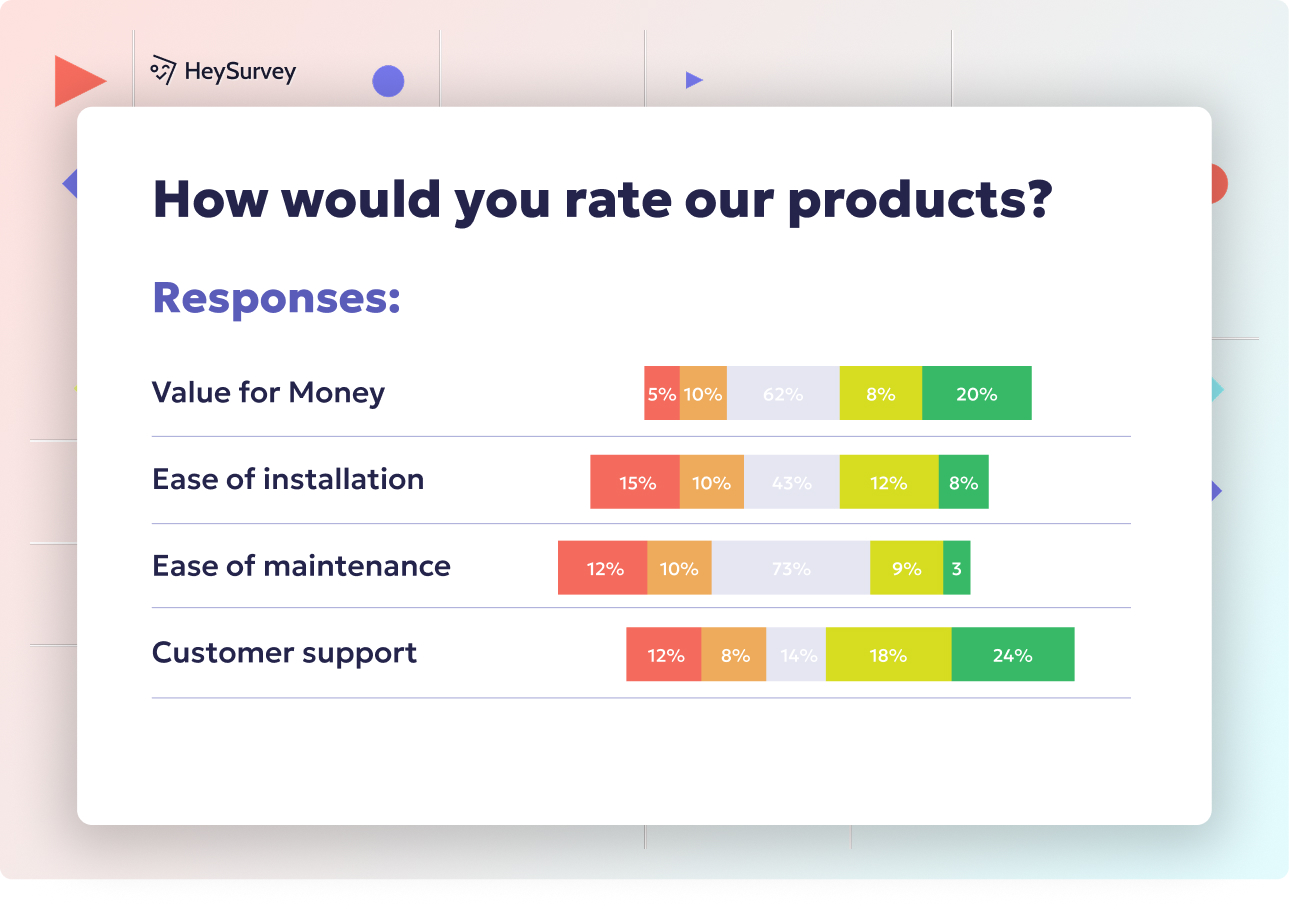
29 Cultural Competence Assessment Survey Questions for Success
Explore 30 cultural competence assessment survey questions across seven types to effectively meas...
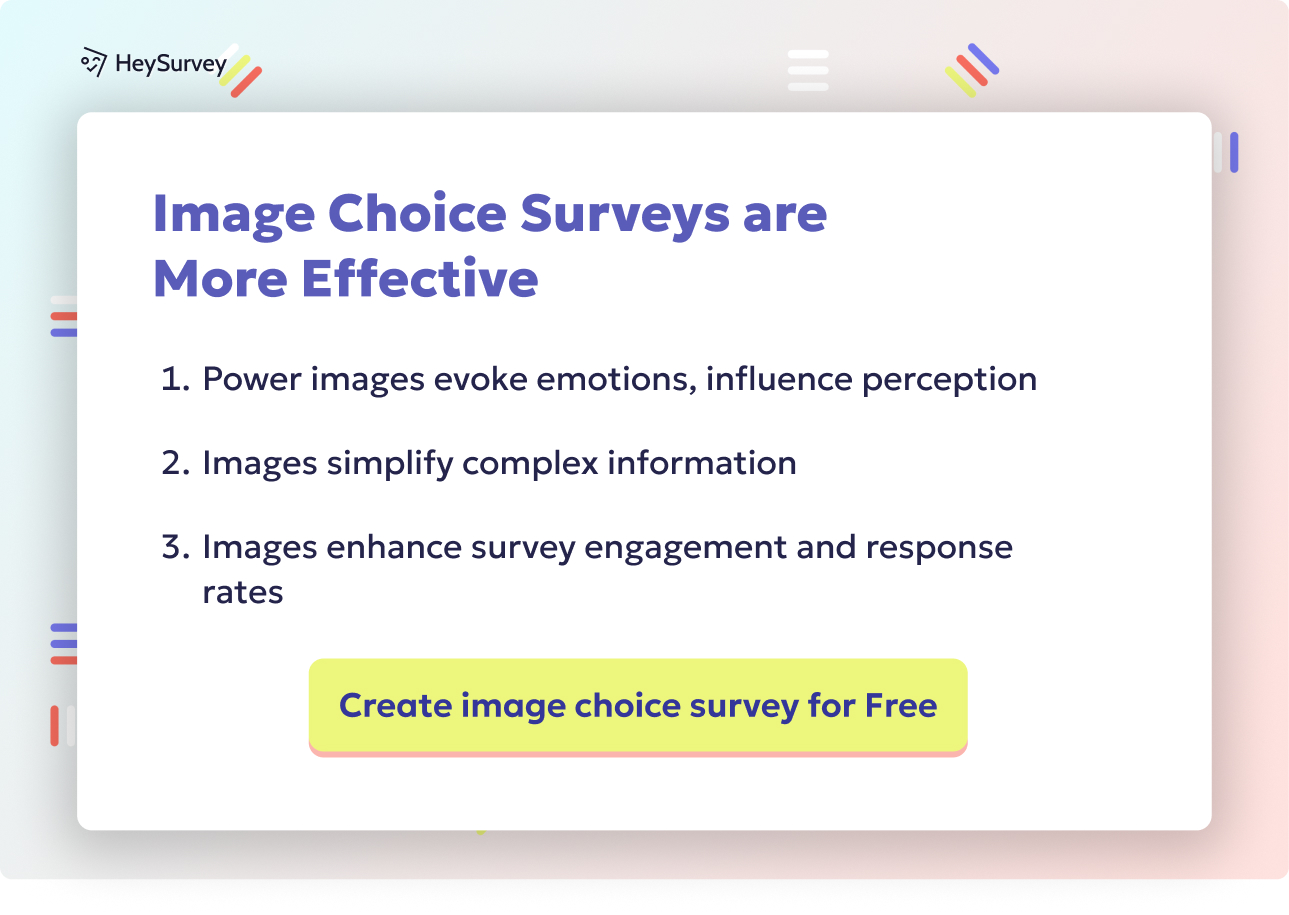
31 Religion Survey Questions: Ultimate Guide to Question Types
Explore comprehensive religion survey questions featuring 28 sample items to capture faith identi...

29 Gender Equality Survey Questions to Drive Real Change
Explore 30 insightful gender equality survey questions across workplace, education, marketing, an...
